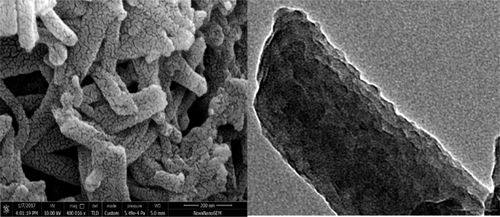当前位置:
X-MOL 学术
›
ACS Sustain. Chem. Eng.
›
论文详情
Our official English website, www.x-mol.net, welcomes your
feedback! (Note: you will need to create a separate account there.)
Multicomponent Template Effects—Preparation of Highly Porous Polyaniline Nanorods Using Crude Lemon Juice and Its Application for Selective Detection of Catechol
ACS Sustainable Chemistry & Engineering ( IF 7.1 ) Pub Date : 2018-01-16 00:00:00 , DOI: 10.1021/acssuschemeng.7b03705 Vineeta Gautam 1, 2 , Karan P. Singh 2 , Vijay L. Yadav 1
ACS Sustainable Chemistry & Engineering ( IF 7.1 ) Pub Date : 2018-01-16 00:00:00 , DOI: 10.1021/acssuschemeng.7b03705 Vineeta Gautam 1, 2 , Karan P. Singh 2 , Vijay L. Yadav 1
Affiliation

|
This paper deals with the preparation and characterization of three different polyaniline samples, namely, PANI-HCl (synthesis in inorganic acid), PANI-Citric acid (synthesis in organic acid), and PANI-Lemon (synthesis in crude lemon juice–biological-derived acidic solution). PANI-Lemon is a low-density polymer with well-defined nanorod shape morphology (∼100 nm in diameter and ∼300–600 nm in length). Lemon juice manipulates the morphology of PANI because it has a lower pKa and the matrix molecules produce template-like effects. The distinct structure of PANI-Lemon was confirmed from microscopic and spectroscopic analysis. In the same protonating condition, the alignment of chains is the dominating factor which governs the conductivity of polyaniline. PANI-Lemon was successfully applied for the electrocatalytic detection of catechol. The selective interaction of PANI-Lemon with catechol leads to the generation of a new redox center. PANI-Lemon-modified carbon paste electrode exhibited high sensitivity (49.68 μA μM–1 cm–2), specificity, a wide linear range (from 5 μM to 100 mM), a low detection limit (2.1 μM), and less response time (2 s). On the basis of our results, we propose an eco-friendly concept "multicomponent template effects" to bring nanoscale morphological manipulation using a suitable natural extract. This concept could be equally implemented to synthetic polymers and other nanoparticles.
中文翻译:

多组分模板效果—粗柠檬汁制备高多孔聚苯胺纳米棒及其在邻苯二酚的选择性检测中的应用
本文介绍了三种不同的聚苯胺样品的制备和表征,分别是PANI-HCl(在无机酸中合成),PANI-柠檬酸(在有机酸中合成)和PANI-柠檬(在粗柠檬汁中合成-生物燃料)。衍生的酸性溶液)。PANI-柠檬是一种低密度聚合物,具有明确的纳米棒形状形态(直径约100 nm,长度约300-600 nm)。柠檬汁具有较低的p K a,可操纵PANI的形态。基质分子产生类似模板的效果。通过显微镜和光谱分析证实了PANI-柠檬的独特结构。在相同的质子化条件下,链的排列是决定聚苯胺电导率的主要因素。PANI-柠檬已成功用于儿茶酚的电催化检测。PANI-柠檬与邻苯二酚的选择性相互作用导致生成新的氧化还原中心。PANI-柠檬改性的碳糊电极表现出高灵敏度(49.68μAμM –1 cm –2),特异性,宽线性范围(5μM至100 mM),低检测限(2.1μM)和较短的响应时间(2 s)。根据我们的结果,我们提出了一种生态友好的概念“多组分模板效应”,以使用合适的天然提取物带来纳米级的形态学处理。该概念可以同等地应用于合成聚合物和其他纳米粒子。
更新日期:2018-01-16
中文翻译:

多组分模板效果—粗柠檬汁制备高多孔聚苯胺纳米棒及其在邻苯二酚的选择性检测中的应用
本文介绍了三种不同的聚苯胺样品的制备和表征,分别是PANI-HCl(在无机酸中合成),PANI-柠檬酸(在有机酸中合成)和PANI-柠檬(在粗柠檬汁中合成-生物燃料)。衍生的酸性溶液)。PANI-柠檬是一种低密度聚合物,具有明确的纳米棒形状形态(直径约100 nm,长度约300-600 nm)。柠檬汁具有较低的p K a,可操纵PANI的形态。基质分子产生类似模板的效果。通过显微镜和光谱分析证实了PANI-柠檬的独特结构。在相同的质子化条件下,链的排列是决定聚苯胺电导率的主要因素。PANI-柠檬已成功用于儿茶酚的电催化检测。PANI-柠檬与邻苯二酚的选择性相互作用导致生成新的氧化还原中心。PANI-柠檬改性的碳糊电极表现出高灵敏度(49.68μAμM –1 cm –2),特异性,宽线性范围(5μM至100 mM),低检测限(2.1μM)和较短的响应时间(2 s)。根据我们的结果,我们提出了一种生态友好的概念“多组分模板效应”,以使用合适的天然提取物带来纳米级的形态学处理。该概念可以同等地应用于合成聚合物和其他纳米粒子。











































 京公网安备 11010802027423号
京公网安备 11010802027423号